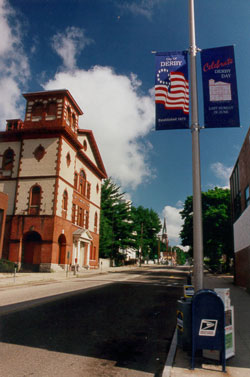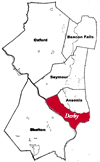Sterling Opera HouseThe Opera House (on your left) is unusual for its Italian Victorian architectural treatment in a public building. The design balances symmetrical and asymmetrical effects: the asymmetrical tower is balanced by the window treatment. The house was built in 1889 to seat 1250, and possesses an excellent stage. The theater opened on April 2, 1889 and remained in use until 1945. Two lower levels served as a City Hall and Police Station until 1965. Designer H.E. Ficken, one of the creators of Carnegie Hall, combined several architectural styles in the Sterling. The exterior and roof-top and the interior walls and doorways are Italianate Victorian and display the final evolution of the Italian Baroque opera house. The interior seating plan was influenced by German composer Richard Wager's conception of a triangle seating arrangement, with all seats enjoying an unobstructed view of the stage. No box seats were used, but two "piano boxes" were located on either side of the stage to accommodate two Sterling Pianos. A proscenium arch frames the 60-by-34-foot stage. Below are 10 dressing rooms. The auditorium boasts an orchestra pit, two gracefully sweeping balconies and fine examples of bottle glass, keystone arches and wrought iron work. Acoustically, the Sterling has no equal. Even a whisper can be heard clearly from all areas of the auditorium. Comedian Red Skelton, composer John Philip Sousa and dancer Donald O’Connor all appeared on the stage of the Sterling Opera House during its heyday as a vaudeville palace. Renowned magician Harry Houdini once performed feats of magic and daring escapes at the Sterling. Aviatrix Amelia Earhart addressed the local Women’s Club here in 1936. Lionel Barrymore, a legend of American theater, joined his famous relatives, John and Ethel Barrymore, in appearances at the Sterling. Ex-heavyweight champion John L. Sullivan performed the role of Simon Legree in a Sterling Opera House production of Uncle Tom’s Cabin and silent film-maker D.W. Griffith was so pleased with the reception his Birth of a Nation received in Derby that he used the theater to try out several of his subsequent films before their general release. The turn of the century brought an increase in labor unrest in the Valley. The most famous incident occurred when seventy women in the underwear room of the Paugussett Mills walked off the job on strike. The strike was only settled after fifty-four days when the famed AFL president Samuel Gompers personally came to Derby, and in one day, after numerous meetings, announced the settlement to a packed Opera House. |
|

